University ACS Assignment: IT Governance, Standards, and Privacy
VerifiedAdded on 2020/05/28
|7
|1192
|83
Homework Assignment
AI Summary
This document presents a comprehensive solution to an ACS assignment, addressing key aspects of IT governance, Australian ICT standards, and the Privacy Act. The assignment explores how a company's established IT governance framework supports business objectives, ensures data protection, and manages risks through the Factor Analysis of Information Risk (FAIR) method. It also examines the importance of adhering to Australian ICT standards to ensure excellent performance and evaluate risks related to ICT activities. Furthermore, the solution emphasizes the significance of the Privacy Act in handling client information, including its collection, storage, and access, demonstrating how ICT practitioners must comply with regulations to maintain data confidentiality and integrity. The solution incorporates relevant literature and real-world examples to support the analysis.
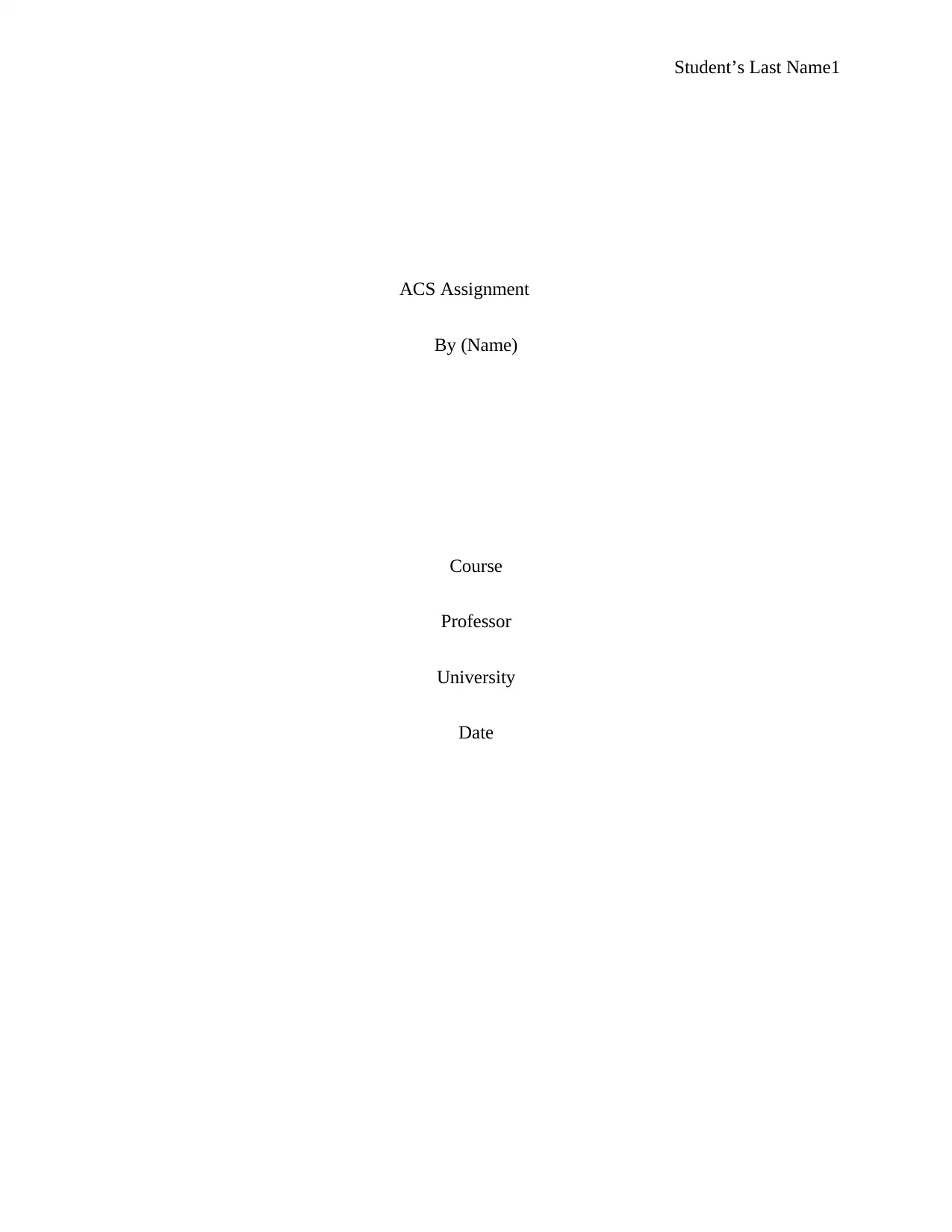
Student’s Last Name1
ACS Assignment
By (Name)
Course
Professor
University
Date
ACS Assignment
By (Name)
Course
Professor
University
Date
Paraphrase This Document
Need a fresh take? Get an instant paraphrase of this document with our AI Paraphraser
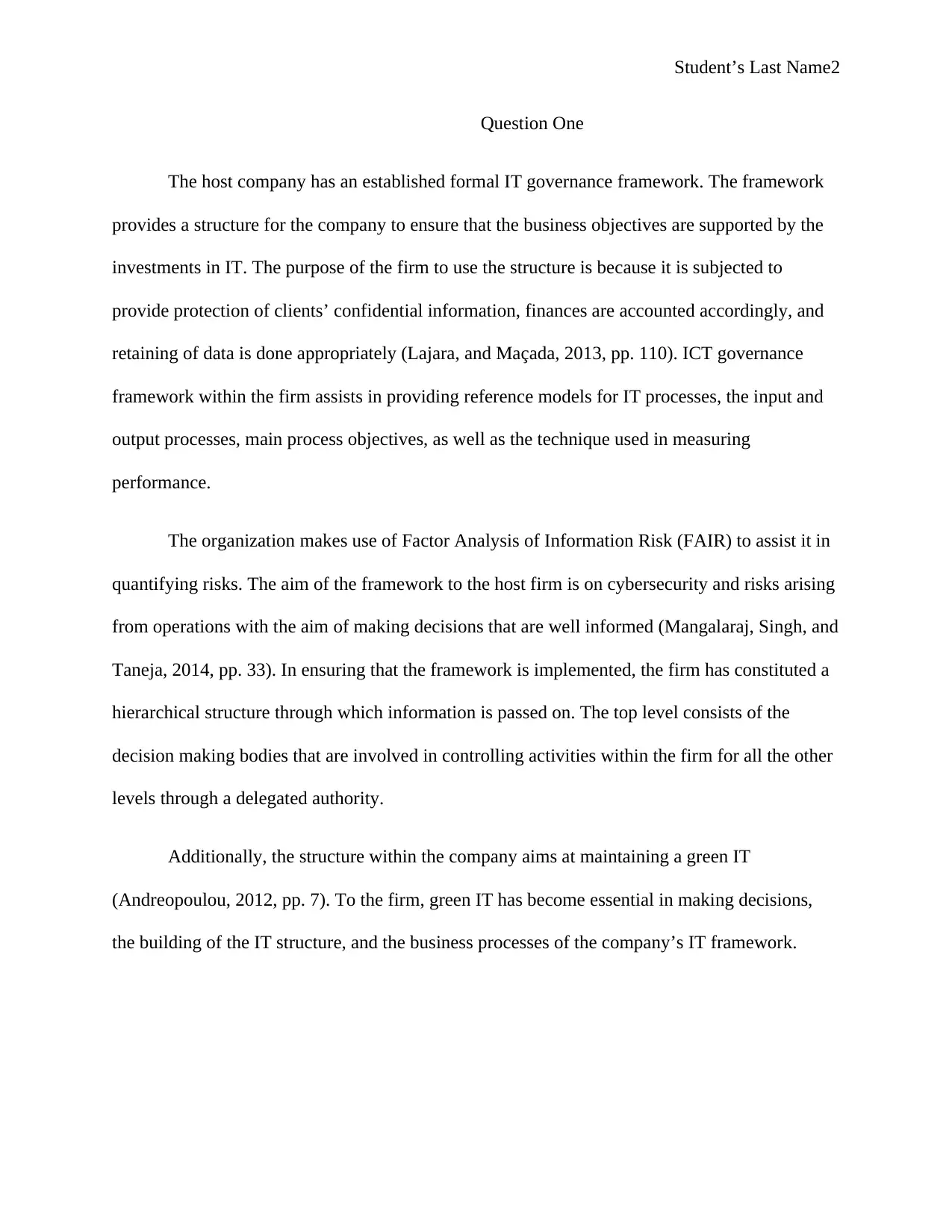
Student’s Last Name2
Question One
The host company has an established formal IT governance framework. The framework
provides a structure for the company to ensure that the business objectives are supported by the
investments in IT. The purpose of the firm to use the structure is because it is subjected to
provide protection of clients’ confidential information, finances are accounted accordingly, and
retaining of data is done appropriately (Lajara, and Maçada, 2013, pp. 110). ICT governance
framework within the firm assists in providing reference models for IT processes, the input and
output processes, main process objectives, as well as the technique used in measuring
performance.
The organization makes use of Factor Analysis of Information Risk (FAIR) to assist it in
quantifying risks. The aim of the framework to the host firm is on cybersecurity and risks arising
from operations with the aim of making decisions that are well informed (Mangalaraj, Singh, and
Taneja, 2014, pp. 33). In ensuring that the framework is implemented, the firm has constituted a
hierarchical structure through which information is passed on. The top level consists of the
decision making bodies that are involved in controlling activities within the firm for all the other
levels through a delegated authority.
Additionally, the structure within the company aims at maintaining a green IT
(Andreopoulou, 2012, pp. 7). To the firm, green IT has become essential in making decisions,
the building of the IT structure, and the business processes of the company’s IT framework.
Question One
The host company has an established formal IT governance framework. The framework
provides a structure for the company to ensure that the business objectives are supported by the
investments in IT. The purpose of the firm to use the structure is because it is subjected to
provide protection of clients’ confidential information, finances are accounted accordingly, and
retaining of data is done appropriately (Lajara, and Maçada, 2013, pp. 110). ICT governance
framework within the firm assists in providing reference models for IT processes, the input and
output processes, main process objectives, as well as the technique used in measuring
performance.
The organization makes use of Factor Analysis of Information Risk (FAIR) to assist it in
quantifying risks. The aim of the framework to the host firm is on cybersecurity and risks arising
from operations with the aim of making decisions that are well informed (Mangalaraj, Singh, and
Taneja, 2014, pp. 33). In ensuring that the framework is implemented, the firm has constituted a
hierarchical structure through which information is passed on. The top level consists of the
decision making bodies that are involved in controlling activities within the firm for all the other
levels through a delegated authority.
Additionally, the structure within the company aims at maintaining a green IT
(Andreopoulou, 2012, pp. 7). To the firm, green IT has become essential in making decisions,
the building of the IT structure, and the business processes of the company’s IT framework.
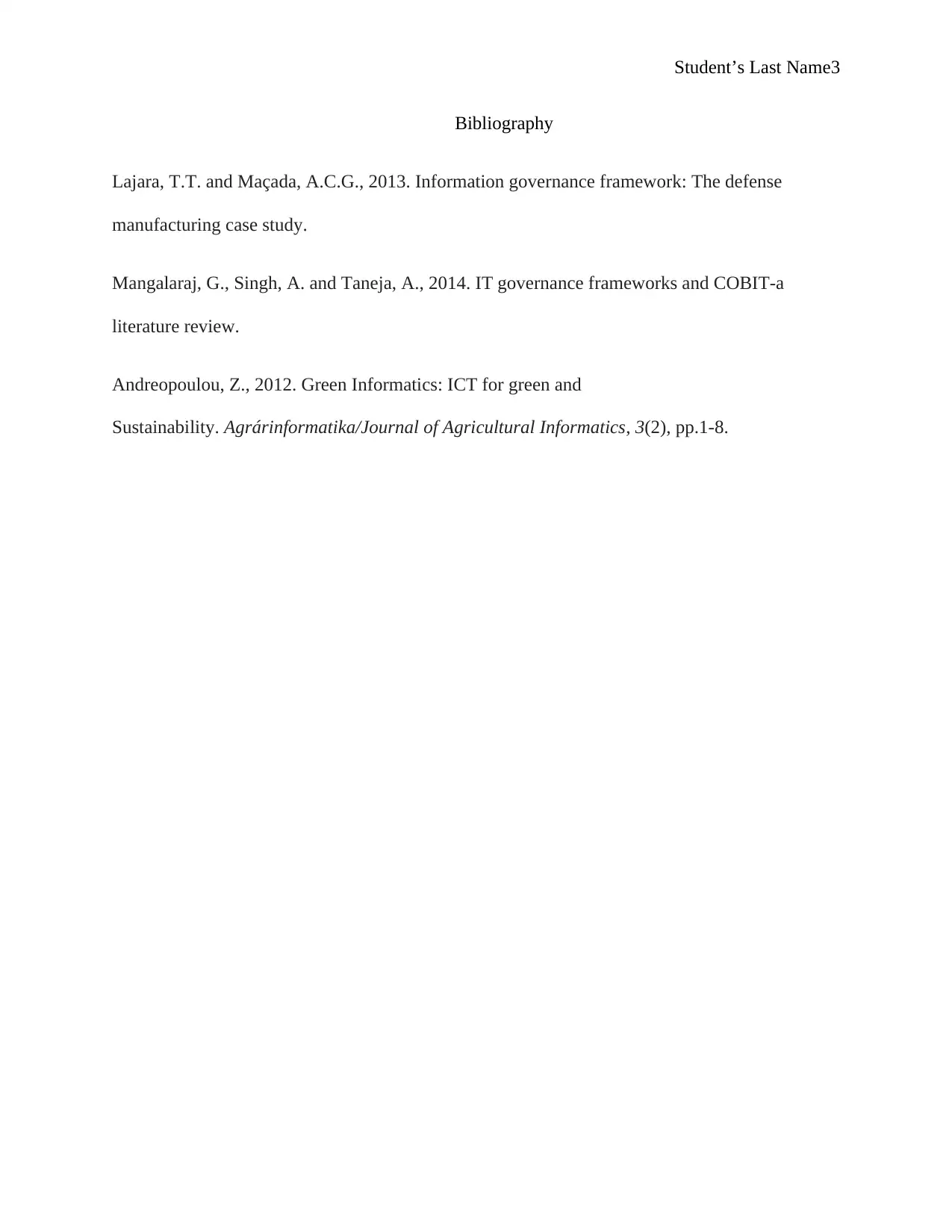
Student’s Last Name3
Bibliography
Lajara, T.T. and Maçada, A.C.G., 2013. Information governance framework: The defense
manufacturing case study.
Mangalaraj, G., Singh, A. and Taneja, A., 2014. IT governance frameworks and COBIT-a
literature review.
Andreopoulou, Z., 2012. Green Informatics: ICT for green and
Sustainability. Agrárinformatika/Journal of Agricultural Informatics, 3(2), pp.1-8.
Bibliography
Lajara, T.T. and Maçada, A.C.G., 2013. Information governance framework: The defense
manufacturing case study.
Mangalaraj, G., Singh, A. and Taneja, A., 2014. IT governance frameworks and COBIT-a
literature review.
Andreopoulou, Z., 2012. Green Informatics: ICT for green and
Sustainability. Agrárinformatika/Journal of Agricultural Informatics, 3(2), pp.1-8.
⊘ This is a preview!⊘
Do you want full access?
Subscribe today to unlock all pages.

Trusted by 1+ million students worldwide
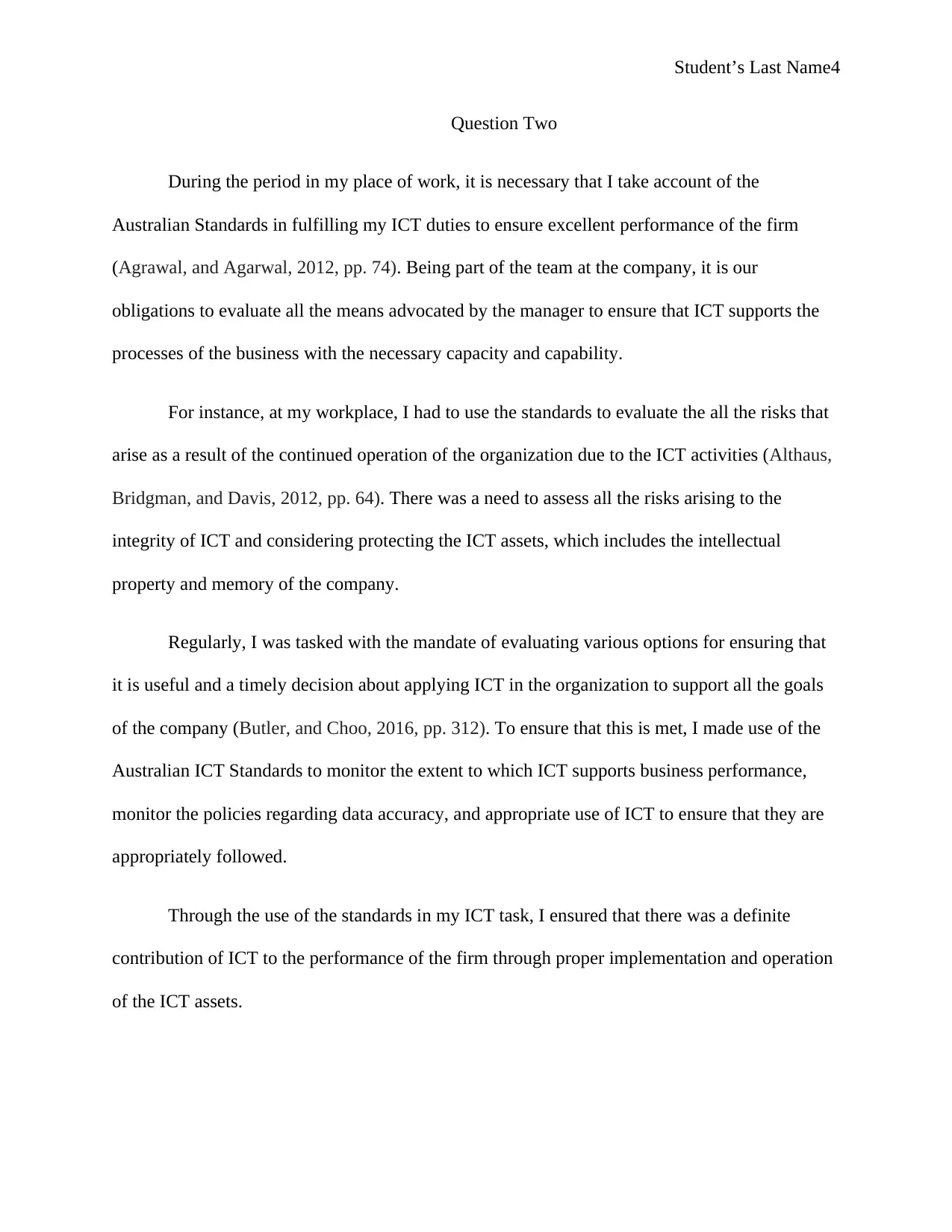
Student’s Last Name4
Question Two
During the period in my place of work, it is necessary that I take account of the
Australian Standards in fulfilling my ICT duties to ensure excellent performance of the firm
(Agrawal, and Agarwal, 2012, pp. 74). Being part of the team at the company, it is our
obligations to evaluate all the means advocated by the manager to ensure that ICT supports the
processes of the business with the necessary capacity and capability.
For instance, at my workplace, I had to use the standards to evaluate the all the risks that
arise as a result of the continued operation of the organization due to the ICT activities (Althaus,
Bridgman, and Davis, 2012, pp. 64). There was a need to assess all the risks arising to the
integrity of ICT and considering protecting the ICT assets, which includes the intellectual
property and memory of the company.
Regularly, I was tasked with the mandate of evaluating various options for ensuring that
it is useful and a timely decision about applying ICT in the organization to support all the goals
of the company (Butler, and Choo, 2016, pp. 312). To ensure that this is met, I made use of the
Australian ICT Standards to monitor the extent to which ICT supports business performance,
monitor the policies regarding data accuracy, and appropriate use of ICT to ensure that they are
appropriately followed.
Through the use of the standards in my ICT task, I ensured that there was a definite
contribution of ICT to the performance of the firm through proper implementation and operation
of the ICT assets.
Question Two
During the period in my place of work, it is necessary that I take account of the
Australian Standards in fulfilling my ICT duties to ensure excellent performance of the firm
(Agrawal, and Agarwal, 2012, pp. 74). Being part of the team at the company, it is our
obligations to evaluate all the means advocated by the manager to ensure that ICT supports the
processes of the business with the necessary capacity and capability.
For instance, at my workplace, I had to use the standards to evaluate the all the risks that
arise as a result of the continued operation of the organization due to the ICT activities (Althaus,
Bridgman, and Davis, 2012, pp. 64). There was a need to assess all the risks arising to the
integrity of ICT and considering protecting the ICT assets, which includes the intellectual
property and memory of the company.
Regularly, I was tasked with the mandate of evaluating various options for ensuring that
it is useful and a timely decision about applying ICT in the organization to support all the goals
of the company (Butler, and Choo, 2016, pp. 312). To ensure that this is met, I made use of the
Australian ICT Standards to monitor the extent to which ICT supports business performance,
monitor the policies regarding data accuracy, and appropriate use of ICT to ensure that they are
appropriately followed.
Through the use of the standards in my ICT task, I ensured that there was a definite
contribution of ICT to the performance of the firm through proper implementation and operation
of the ICT assets.
Paraphrase This Document
Need a fresh take? Get an instant paraphrase of this document with our AI Paraphraser
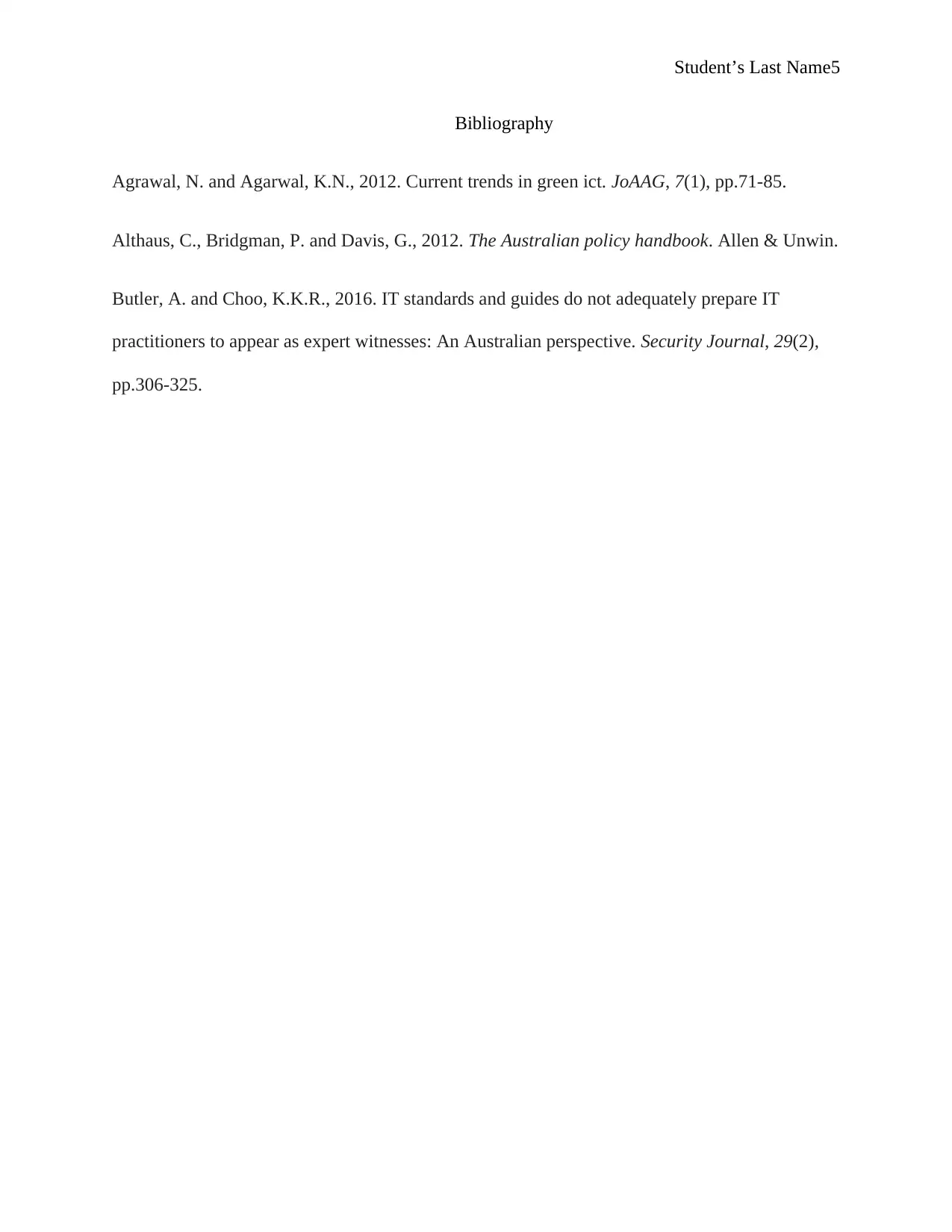
Student’s Last Name5
Bibliography
Agrawal, N. and Agarwal, K.N., 2012. Current trends in green ict. JoAAG, 7(1), pp.71-85.
Althaus, C., Bridgman, P. and Davis, G., 2012. The Australian policy handbook. Allen & Unwin.
Butler, A. and Choo, K.K.R., 2016. IT standards and guides do not adequately prepare IT
practitioners to appear as expert witnesses: An Australian perspective. Security Journal, 29(2),
pp.306-325.
Bibliography
Agrawal, N. and Agarwal, K.N., 2012. Current trends in green ict. JoAAG, 7(1), pp.71-85.
Althaus, C., Bridgman, P. and Davis, G., 2012. The Australian policy handbook. Allen & Unwin.
Butler, A. and Choo, K.K.R., 2016. IT standards and guides do not adequately prepare IT
practitioners to appear as expert witnesses: An Australian perspective. Security Journal, 29(2),
pp.306-325.
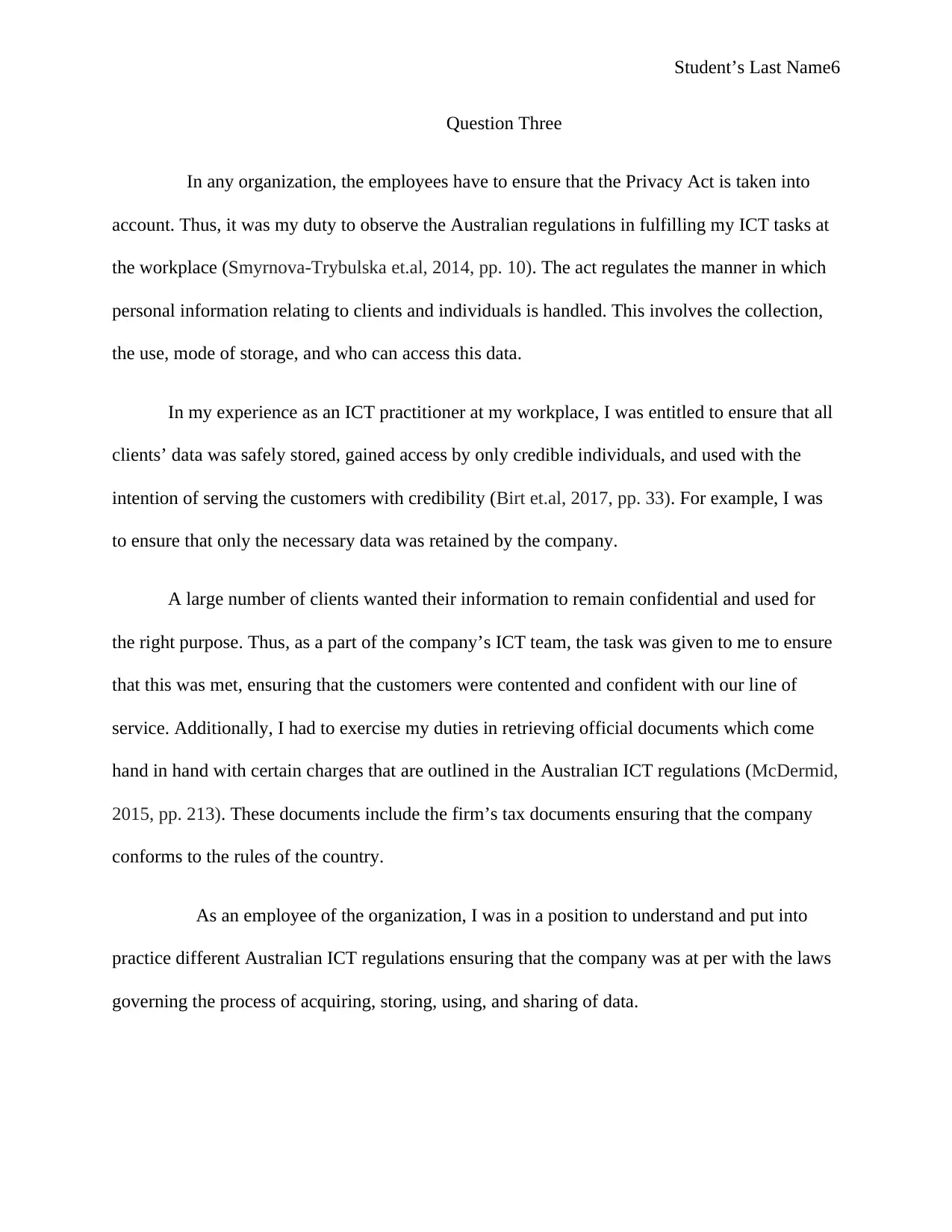
Student’s Last Name6
Question Three
In any organization, the employees have to ensure that the Privacy Act is taken into
account. Thus, it was my duty to observe the Australian regulations in fulfilling my ICT tasks at
the workplace (Smyrnova-Trybulska et.al, 2014, pp. 10). The act regulates the manner in which
personal information relating to clients and individuals is handled. This involves the collection,
the use, mode of storage, and who can access this data.
In my experience as an ICT practitioner at my workplace, I was entitled to ensure that all
clients’ data was safely stored, gained access by only credible individuals, and used with the
intention of serving the customers with credibility (Birt et.al, 2017, pp. 33). For example, I was
to ensure that only the necessary data was retained by the company.
A large number of clients wanted their information to remain confidential and used for
the right purpose. Thus, as a part of the company’s ICT team, the task was given to me to ensure
that this was met, ensuring that the customers were contented and confident with our line of
service. Additionally, I had to exercise my duties in retrieving official documents which come
hand in hand with certain charges that are outlined in the Australian ICT regulations (McDermid,
2015, pp. 213). These documents include the firm’s tax documents ensuring that the company
conforms to the rules of the country.
As an employee of the organization, I was in a position to understand and put into
practice different Australian ICT regulations ensuring that the company was at per with the laws
governing the process of acquiring, storing, using, and sharing of data.
Question Three
In any organization, the employees have to ensure that the Privacy Act is taken into
account. Thus, it was my duty to observe the Australian regulations in fulfilling my ICT tasks at
the workplace (Smyrnova-Trybulska et.al, 2014, pp. 10). The act regulates the manner in which
personal information relating to clients and individuals is handled. This involves the collection,
the use, mode of storage, and who can access this data.
In my experience as an ICT practitioner at my workplace, I was entitled to ensure that all
clients’ data was safely stored, gained access by only credible individuals, and used with the
intention of serving the customers with credibility (Birt et.al, 2017, pp. 33). For example, I was
to ensure that only the necessary data was retained by the company.
A large number of clients wanted their information to remain confidential and used for
the right purpose. Thus, as a part of the company’s ICT team, the task was given to me to ensure
that this was met, ensuring that the customers were contented and confident with our line of
service. Additionally, I had to exercise my duties in retrieving official documents which come
hand in hand with certain charges that are outlined in the Australian ICT regulations (McDermid,
2015, pp. 213). These documents include the firm’s tax documents ensuring that the company
conforms to the rules of the country.
As an employee of the organization, I was in a position to understand and put into
practice different Australian ICT regulations ensuring that the company was at per with the laws
governing the process of acquiring, storing, using, and sharing of data.
⊘ This is a preview!⊘
Do you want full access?
Subscribe today to unlock all pages.

Trusted by 1+ million students worldwide

Student’s Last Name7
Bibliography
Birt, J., Wells, P., Kavanagh, M., Robb, A. and Bir, P., 2017. ICT literature review.
McDermid, D., 2015. Ethics in ICT: an Australian perspective. Pearson Higher Education AU.
Smyrnova-Trybulska, E., Cubo, D.S., Pinto, P. and Malach, J., 2014. The general concept of
analyses and implementation of the legal, ethical, human, technical and social factors of ICT and
e-learning development in several European countries–international research network. Збірник
наукових праць Дніпродзержинського державного технічного університету. Технічні
науки, pp.3-14.
Bibliography
Birt, J., Wells, P., Kavanagh, M., Robb, A. and Bir, P., 2017. ICT literature review.
McDermid, D., 2015. Ethics in ICT: an Australian perspective. Pearson Higher Education AU.
Smyrnova-Trybulska, E., Cubo, D.S., Pinto, P. and Malach, J., 2014. The general concept of
analyses and implementation of the legal, ethical, human, technical and social factors of ICT and
e-learning development in several European countries–international research network. Збірник
наукових праць Дніпродзержинського державного технічного університету. Технічні
науки, pp.3-14.
1 out of 7
Related Documents
Your All-in-One AI-Powered Toolkit for Academic Success.
+13062052269
info@desklib.com
Available 24*7 on WhatsApp / Email
![[object Object]](/_next/static/media/star-bottom.7253800d.svg)
Unlock your academic potential
Copyright © 2020–2025 A2Z Services. All Rights Reserved. Developed and managed by ZUCOL.




